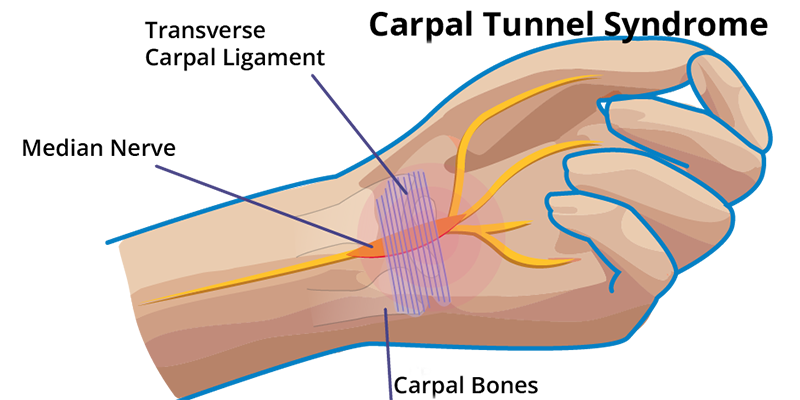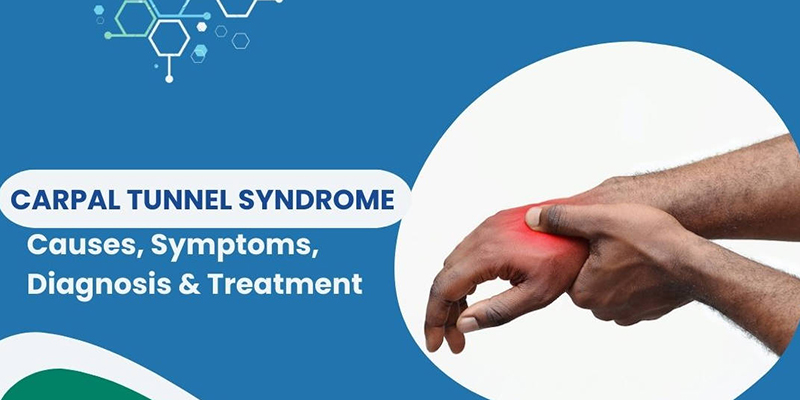What Is Carpal Tunnel Syndrome And How To Prevent It?
Carpal Tunnel Syndrome (CTS) is a common condition resulting from pressure on the median nerve in the wrist, manifesting in pain, numbness, and tingling sensations within the hand. In today’s digital age, the prevalence of CTS has surged, particularly among office workers, factory employees, and those engaged in repetitive tasks.
Carpal Tunnel Syndrome (CTS) is a common condition resulting from pressure on the median nerve in the wrist. It manifests in pain, numbness, and tingling sensations in the hand. In today's digital age, the prevalence of CTS has surged, particularly among office workers, factory employees, and those engaged in repetitive tasks.

Understanding CTS is essential, significantly impacting millions' daily activities and productivity. This highlights the need for awareness and effective prevention strategies to maintain overall health and well-being in our fast-paced work environments.
Understanding Carpal Tunnel Syndrome
A. Definition Of Carpal Tunnel Syndrome
Carpal Tunnel Syndrome (CTS) arises when the median nerve, which traverses from the forearm to the palm, experiences compression as it passes through a narrow canal in the wrist called the carpal tunnel. This structure is made up of bones and ligaments. The median nerve is crucial for sensation in the thumb, index, middle finger, and part of the ring finger, and it also plays a role in controlling specific hand muscles. When the carpal tunnel narrows or becomes inflamed, it can exert pressure on the median nerve, leading to the symptoms associated with CTS.
B. Causes
CTS's primary causes are repetitive hand movements, particularly awkward wrist positions, like typing or using a mouse. Jobs with repetitive tasks, such as assembly line work or data entry, can worsen these conditions. Additionally, specific medical issues such as diabetes, rheumatoid arthritis, and hypothyroidism heighten the risk of developing CTS due to their deleterious effects on nerve health and inflammation. Anatomical factors may also play a role; some individuals have a naturally smaller carpal tunnel, increasing their susceptibility to this condition.
C. Symptoms
Individuals with carpal tunnel syndrome commonly experience numbness, tingling, and discomfort in the hand and fingers, especially during the night or while engaging in activities that necessitate wrist flexion, such as typing or talking on a mobile phone. These symptoms can significantly disrupt daily life, challenging simple tasks like buttoning a shirt or grasping objects. In more severe instances, weakness in the hand can develop, complicating everyday activities and reducing functionality. Prompt recognition and attention to these symptoms are essential to prevent progression and avert potential permanent nerve damage.
Diagnosis Of Carpal Tunnel Syndrome
Diagnosing carpal tunnel syndrome (CTS) involves two significant components: clinical evaluation and differential diagnosis. The clinical assessment begins with healthcare professionals reviewing the patient's history and taking close note of symptom reports, including tingling, numbness, or pain in the hand and fingers. Physical examinations may be carried out to evaluate tenderness, swelling, and any signs of weakness in the hand. Additionally, nerve conduction studies are crucial; these tests gauge the speed at which electrical signals traverse the median nerve, confirming any nerve compression in the carpal tunnel.
Following clinical evaluations, doctors must distinguish CTS from other conditions, such as arthritis, tendinitis, or cervical radiculopathy, that may exhibit similar symptoms. This step, known as differential diagnosis, often entails further testing, including imaging scans or assessing the wrist's range of motion. By thoroughly understanding each patient's unique symptoms, healthcare professionals can accurately identify CTS and craft suitable treatment plans, ensuring optimal patient outcomes.

Ultimately, a thorough diagnosis is vital in managing carpal tunnel syndrome effectively and enhancing patients' quality of life.
Treatment Options For Carpal Tunnel Syndrome
Experiencing carpal tunnel syndrome (CTS) can significantly disrupt everyday activities, but various treatment methods are available to manage the condition effectively. This section discusses non-surgical and surgical treatment options to provide a well-rounded understanding.
A. Non-Surgical Treatments
The initial approach to managing CTS often focuses on non-invasive methods. A frequently recommended strategy involves using wrist braces, which assist in keeping the wrist in a neutral position during sleep or tasks, relieving pressure on the median nerve. Many individuals report noticeable relief after consistently using these supports. Physical therapy can also be beneficial; therapists may employ stretching exercises and ultrasound therapy to enhance mobility and reduce nerve irritation. Moreover, corticosteroid injections can be utilized to alleviate inflammation and swelling, providing rapid relief for those enduring significant pain.
B. Surgical Treatments
For individuals who do not achieve relief from conservative treatment methods, surgical options might be considered. The most common technique is the carpal tunnel release, which entails severing the ligament that compresses the median nerve. This minimally invasive procedure is usually performed on an outpatient basis, allowing patients to return home the same day. Post-surgery, a rehabilitation phase commences, where patients participate in gentle exercises designed to restore strength and movement in the wrist. While surgery is not always required, it can be an appropriate option for those with chronic and incapacitating symptoms of CTS.
Prevention Of Carpal Tunnel Syndrome
A. Ergonomic Practices
Implementing an ergonomically friendly workspace can drastically diminish the likelihood of developing carpal tunnel syndrome (CTS). Below are essential ergonomic tips to apply:
• Keyboard Positioning: Ensure the keyboard is at elbow height, with forearms kept parallel to the ground to minimize wrist strain.
• Mouse Usage: Use an ergonomic mouse that comfortably fits your hand. Keep it close to the keyboard to avoid excessive reaching.
• Wrist Support: Opt for wrist rests or number pads to maintain straight wrists during typing.
• Chair Adjustments: Select a chair that offers lower back support and allows feet to rest flat on the floor.
B. Regular Breaks And Exercises
Incorporating regular breaks and engaging in specific exercises can help relieve tension before it escalates into discomfort. Here are some preventative strategies:
• Break Schedule: Take a 5-10 minute break every hour to stretch and move around, helping to prevent stiffness and fatigue.
• Wrist Flexor Stretch: Extend your arm forward, palm up, and gently pull back on your fingers using your opposite hand.
• Wrist Extensor Stretch: Extend your arm with the palm downward and pull back on your fingers.
• Finger Flexion and Extension: Clench your fist and extend your fingers wide, repeating this motion ten times.
C. Lifestyle Modifications
Several lifestyle changes can significantly assist in preventing CTS:
• Minimize Repetitive Movements: Whenever possible, alternate between tasks requiring repetitive motions to allow hand recovery periods.
• Exercise Regularly: Engage in activities that promote overall fitness while strengthening the wrists and hands, including swimming, Yoga, and weight training.
• Healthy Weight Management: Maintain a healthy weight to minimize pressure on the wrist area.
Encouraging these practical approaches can protect your hands and wrists, fostering a healthier environment to avert carpal tunnel syndrome. Ultimately, grasping the fundamentals of carpal tunnel syndrome is critical in safeguarding hand health. Proactive measures and early interventions—like ergonomic organization and regular pauses—are vital in alleviating symptoms. Individuals can effectively lower their risk by prioritizing these strategies while enhancing their well-being.







